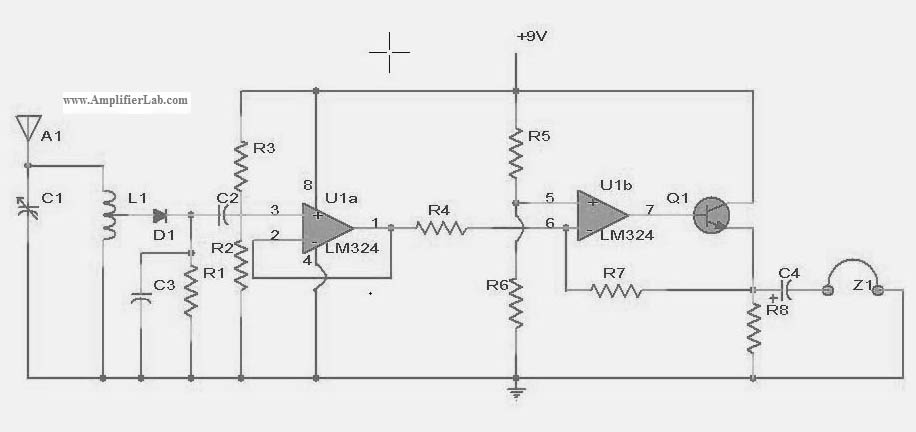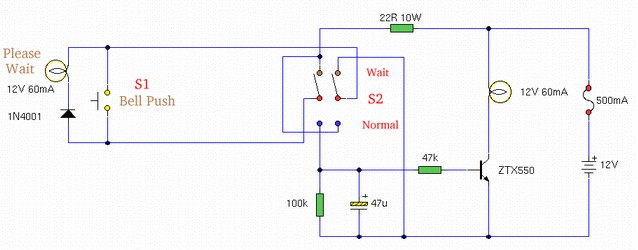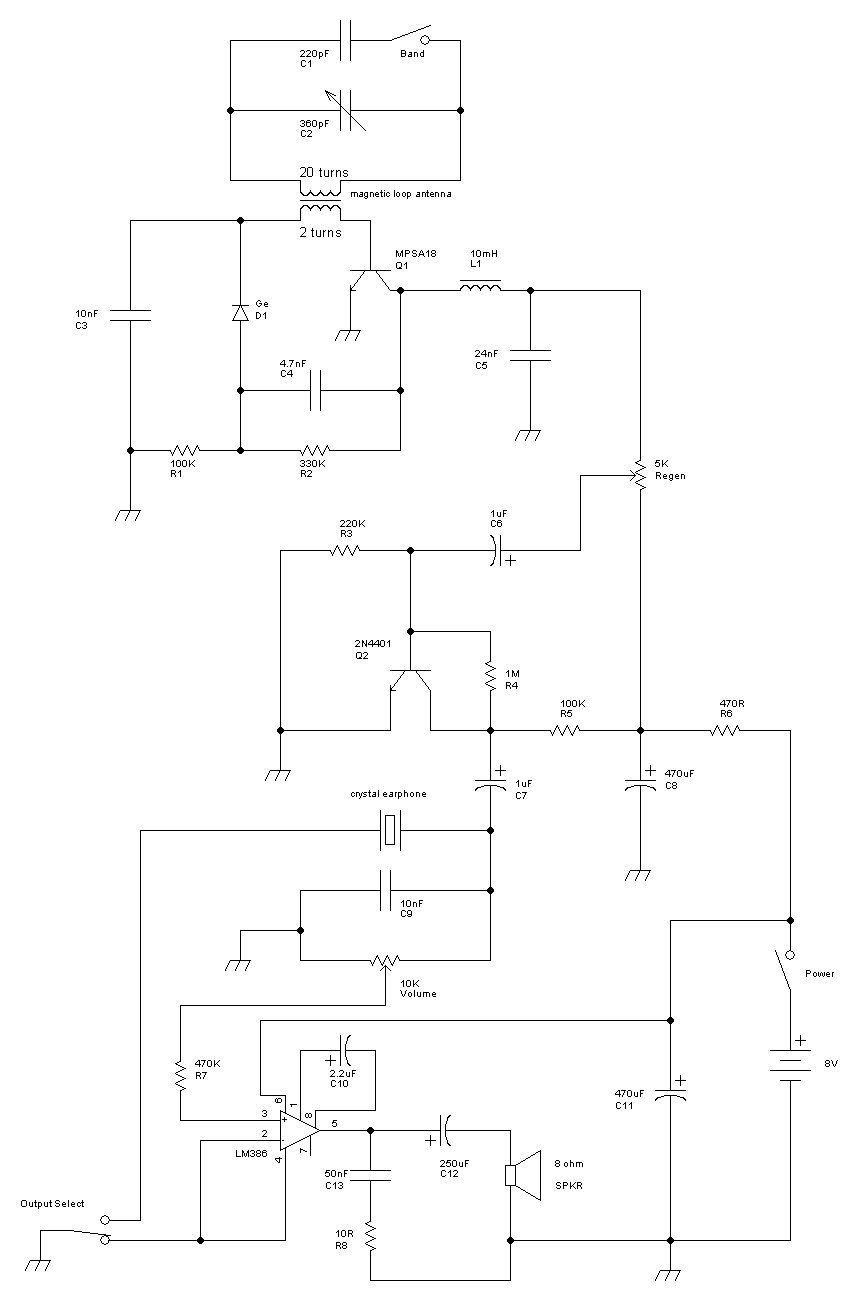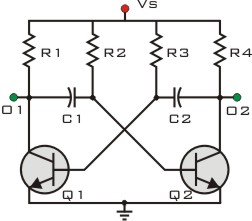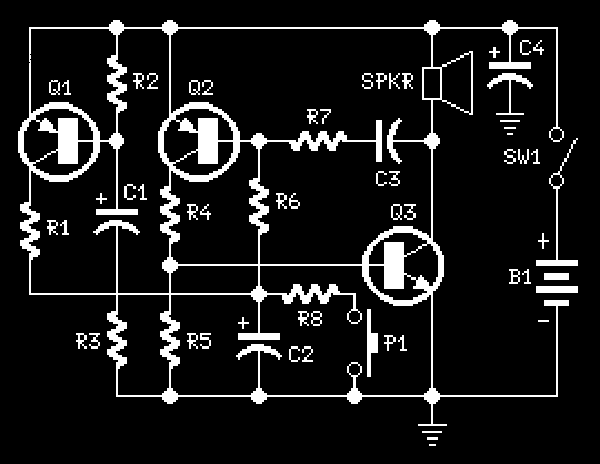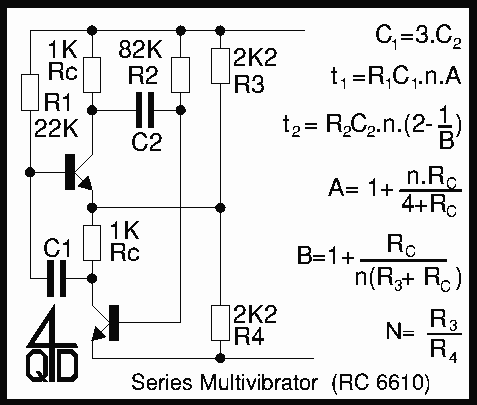
varactor diodes circuits
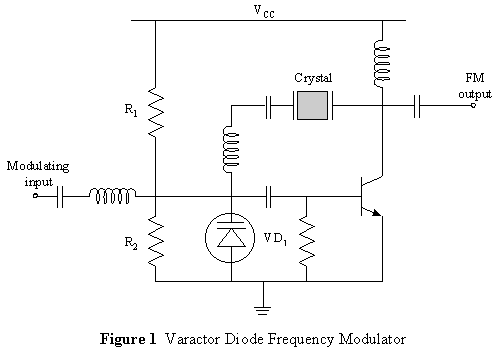
The curves for a capacitor exhibit significant non-linearity, which can be utilized in circuits to modulate, demodulate, and multiply frequencies. This characteristic is known as non-linear reactance rather than resistance, resulting in minimal energy loss. The charge stored in a capacitor is given by the formula Q = CV, where Q represents charge, C is capacitance, and V is voltage. The capacitance-voltage relationship approximates the reciprocal of the square root of the applied voltage. By combining the equations Q = CV and C approximately equal to 1/V^0.5, it becomes evident that the charge on the capacitor is proportional to the square root of the voltage. When an RF voltage is applied to a capacitive reactance that behaves in this manner, a heavily distorted charge is generated, primarily consisting of the second harmonic of the input, which can be extracted using a tuned circuit. A diode functioning in this capacity is referred to as a varactor diode. This principle can be demonstrated using a zener diode as the non-linear element and a signal generator tuned to approximately 500 kHz, producing an output of about 0.25 to 0.5 V RMS. In the accompanying diagrams, the circuit is divided into two segments: the left side is tuned to 500 kHz, while the right side is tuned to 1 MHz. An RF current is directed through the diode at 500 kHz; due to the diode's non-linear reactance, a portion of its second harmonic circulates in the right segment of the circuit. L1 and L2 are intermediate frequency (IF) transformer coils, with L1 potentially comprising two series coils (in phase) tuned to resonate at 500 kHz with the diode in the circuit, and L2 being a single coil tuned to resonate at 1 MHz. Resonance can be measured across the entire coil using a low-capacitance, high-impedance RF probe. After tuning each circuit, applying 500 kHz to L1 allows for measurement of the output across L2. Careful tuning of this coil is essential, as the resonance peak is very sharp. To verify that this frequency is produced by the diode and not merely generator harmonics passing through, 1 MHz can be applied from the generator to L1 to observe the output response. With a reasonable quality factor (Q) in the coils, the output will be minimal. An additional verification method involves replacing the diode with an equivalent capacitance; this will significantly reduce the output. Other harmonics can similarly be generated; for instance, the second harmonic can mix with the fundamental frequency to produce the third harmonic, and the second can create a distorted charge for the fourth harmonic, with improved output for the fourth harmonic when the third is also generated. In all multiplier circuits, it is crucial to allow current to circulate through the diode at all respective frequencies using circuits tuned to those frequencies. These circuits, excluding the output circuit, are referred to as idlers. All tuned circuits must maintain maximum unloaded Q to minimize circuit losses and can be categorized as either parallel- or series-tuned, depending on the perspective taken. Various configurations of varactor multipliers exist, including doubling, tripling, and quadrupling or quintupling. Additionally, there are methods to adjust the bias to position the input RF along different points of the curve, which may enhance performance. The average capacitance of the diode (at a specific voltage) is in series with the tuning capacitance, both of which tune the coil. A well-designed doubler of this nature, utilizing a diode specifically intended for this application, can achieve an output of approximately 90% of the input, with the remainder dissipated in circuit resistances. Initially, there was some surprise that these multipliers could accept an AM input. Typically, frequency multipliers do not yield coherent output with AM inputs; however, it appears that a non-linear reactance can demodulate at the input frequency and remodulate at the output frequency, albeit with some added harmonic distortion, resulting in a usable output.
The described circuit utilizes the non-linear properties of capacitors and diodes to achieve frequency multiplication through harmonic generation. The fundamental principle relies on the behavior of the varactor diode, which changes its capacitance based on the applied voltage, facilitating the generation of harmonics when exposed to RF signals. The design of the circuit is critical, as the tuning of the coils (L1 and L2) must be precise to ensure optimal resonance at the desired frequencies. The use of high-quality components and careful tuning techniques will enhance the performance of the circuit, allowing for efficient frequency multiplication while minimizing losses. The interaction between the fundamental frequency and its harmonics creates a rich output spectrum, which can be exploited in various applications, including signal processing and communication systems. The ability to demodulate AM signals and remodulate them at a different frequency is particularly valuable in modern RF applications, indicating the versatility and effectiveness of non-linear reactive components in electronic design.The curves for a capacitor are all markedly non-linear and this property can be used as an element in a circuit to modulate, demodulate and multiply frequency. This is non-linear reactance, rather than a resistance, however, and because of this, very little loss occurs.
The charge in a capacitor is equal to the capacitance multiplied by the voltag e across the capacitor: Q = CV, and the capacitance/voltage curves above approximate very roughly to the reciprocal of the square root of the applied voltage. Combining Q = CV and C approx l/V*0. 5, the charge on the capacitor can be seen to be proportional to the square root of the voltage. If an RF voltage is applied to a capacitative reactance which behaves in this manner, a heavily distorted charge, consisting mainly of the second harmonic of the input, is produced and can be tapped off using a tuned circuit.
A diode used this way is called a varactor diode. This action can easily be demonstrated by using a zener diode as the non-linear element and a signal generator tuned to about 500kHz giving an output of about 0. 25 to 0. 5V rms. In diagrams (a) and (b) above the circuit is in two halves: the left-hand part is tuned to 500kHz and the right-hand part to 1MHz.
RF current is passed through the diode at 500kHz and, due to the non-linear reactance of the diode, a proportion of its second harmonic will (or should be) circulating in the right-hand part of the circuit. L1 and L2 are IF transformer coils: L1 could be two coils in series (aiding), tuned to resonate at 500kHz with the diode in circuit, and L2 one coil tuned to resonate at 1MHz.
Resonance can be measured across the complete coil with a low-capacitance, high-impedance RF probe. Having tuned each circuit, apply 500kHz to L1 and measure the output across L2. Tune this coil up very carefully (the resonance peak is very sharp). To prove this frequency has been produced by the diode and is not just generator harmonics slipping through, apply 1MHz from the generator to L1 and see how much of this gets through to the output. With any reasonable Q in the coils, it will not be very much. Another proof would be to replace the diode with an equivalent capacitance; the output will go down to a very low proportion of the previous value.
Other harmonics can be produced in a similar way. The second harmonic can mix with the fundamental and produce the third, and the second can produce its own distorted charge for the fourth harmonic, although the output of the fourth harmonic is improved if the third is produced as well. In all these circuits for multipliers, current must be allowed to circulate through the diode at all the respective frequencies by circuits that are tuned to those frequencies.
These circuits, excepting the output circuit, are called idlers. All tuned circuits have to be of the maximum unloaded Q to minimize circuit loss and they can be considered either as parallel- or series-tuned, depending on which way one looks at them Various varactor multipliers: doubling in (a), tripling in (b) and quadrupling or quintupling in (c). (d) shows a way of altering the bias to make the input RF lie along some other point of the curve and possibly to improve the effect.
the diode average capacitance (at a certain voltage) is in series with the tuning capacitance and both of these tune the coil. A properly-designed doubler of this kind, using a diode specifically meant for this function, can give an output of about 90 per cent of the input, the rest being dissipated in circuit resistances.
When multipliers of this sort were first used, some surprise was expressed that they could be fed with an AM input. This cannot normally be done with a frequency multiplier, at least to get a coherent output, but it seems that a non-linear reactance can demodulate at the input frequency and remodulate at the output frequency (with a little added harmonic distortion), to give an output whi
🔗 External reference
The described circuit utilizes the non-linear properties of capacitors and diodes to achieve frequency multiplication through harmonic generation. The fundamental principle relies on the behavior of the varactor diode, which changes its capacitance based on the applied voltage, facilitating the generation of harmonics when exposed to RF signals. The design of the circuit is critical, as the tuning of the coils (L1 and L2) must be precise to ensure optimal resonance at the desired frequencies. The use of high-quality components and careful tuning techniques will enhance the performance of the circuit, allowing for efficient frequency multiplication while minimizing losses. The interaction between the fundamental frequency and its harmonics creates a rich output spectrum, which can be exploited in various applications, including signal processing and communication systems. The ability to demodulate AM signals and remodulate them at a different frequency is particularly valuable in modern RF applications, indicating the versatility and effectiveness of non-linear reactive components in electronic design.The curves for a capacitor are all markedly non-linear and this property can be used as an element in a circuit to modulate, demodulate and multiply frequency. This is non-linear reactance, rather than a resistance, however, and because of this, very little loss occurs.
The charge in a capacitor is equal to the capacitance multiplied by the voltag e across the capacitor: Q = CV, and the capacitance/voltage curves above approximate very roughly to the reciprocal of the square root of the applied voltage. Combining Q = CV and C approx l/V*0. 5, the charge on the capacitor can be seen to be proportional to the square root of the voltage. If an RF voltage is applied to a capacitative reactance which behaves in this manner, a heavily distorted charge, consisting mainly of the second harmonic of the input, is produced and can be tapped off using a tuned circuit.
A diode used this way is called a varactor diode. This action can easily be demonstrated by using a zener diode as the non-linear element and a signal generator tuned to about 500kHz giving an output of about 0. 25 to 0. 5V rms. In diagrams (a) and (b) above the circuit is in two halves: the left-hand part is tuned to 500kHz and the right-hand part to 1MHz.
RF current is passed through the diode at 500kHz and, due to the non-linear reactance of the diode, a proportion of its second harmonic will (or should be) circulating in the right-hand part of the circuit. L1 and L2 are IF transformer coils: L1 could be two coils in series (aiding), tuned to resonate at 500kHz with the diode in circuit, and L2 one coil tuned to resonate at 1MHz.
Resonance can be measured across the complete coil with a low-capacitance, high-impedance RF probe. Having tuned each circuit, apply 500kHz to L1 and measure the output across L2. Tune this coil up very carefully (the resonance peak is very sharp). To prove this frequency has been produced by the diode and is not just generator harmonics slipping through, apply 1MHz from the generator to L1 and see how much of this gets through to the output. With any reasonable Q in the coils, it will not be very much. Another proof would be to replace the diode with an equivalent capacitance; the output will go down to a very low proportion of the previous value.
Other harmonics can be produced in a similar way. The second harmonic can mix with the fundamental and produce the third, and the second can produce its own distorted charge for the fourth harmonic, although the output of the fourth harmonic is improved if the third is produced as well. In all these circuits for multipliers, current must be allowed to circulate through the diode at all the respective frequencies by circuits that are tuned to those frequencies.
These circuits, excepting the output circuit, are called idlers. All tuned circuits have to be of the maximum unloaded Q to minimize circuit loss and they can be considered either as parallel- or series-tuned, depending on which way one looks at them Various varactor multipliers: doubling in (a), tripling in (b) and quadrupling or quintupling in (c). (d) shows a way of altering the bias to make the input RF lie along some other point of the curve and possibly to improve the effect.
the diode average capacitance (at a certain voltage) is in series with the tuning capacitance and both of these tune the coil. A properly-designed doubler of this kind, using a diode specifically meant for this function, can give an output of about 90 per cent of the input, the rest being dissipated in circuit resistances.
When multipliers of this sort were first used, some surprise was expressed that they could be fed with an AM input. This cannot normally be done with a frequency multiplier, at least to get a coherent output, but it seems that a non-linear reactance can demodulate at the input frequency and remodulate at the output frequency (with a little added harmonic distortion), to give an output whi
🔗 External reference
